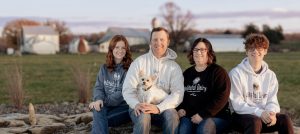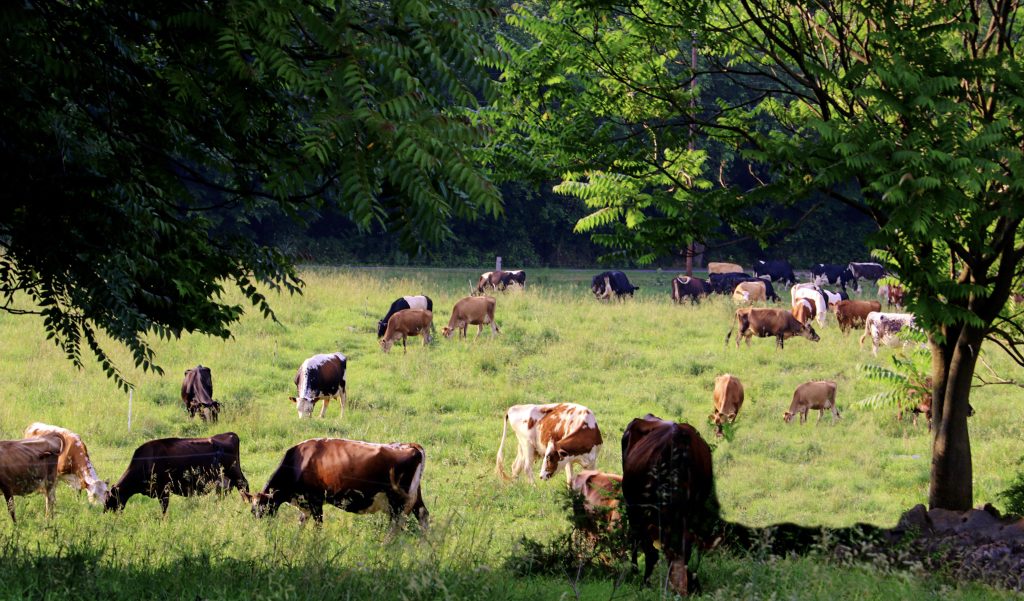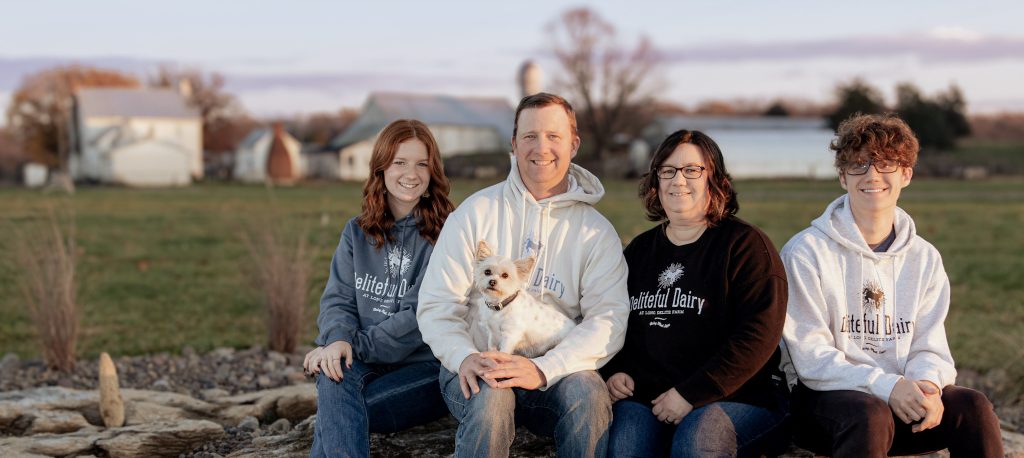
Brooks and Katie Long are both lifelong dairy farmers with big dreams for processing and selling their own dairy products. Owners of Deliteful Dairy at Long Delite Farm in Williamsport, Maryland, the Long family just celebrated five years in business last month.
Brooks is the seventh generation at Long Delite Farm, and Katie grew up on a dairy farm in the Smithsburg area about 20 miles away. They bought the property in 2016, and they have about 50-60 milking cows in their rotational grazing herd. After investing in dairy processing equipment and opening their on-farm store called Deliteful Dairy in 2019, they decided to make fluid milk their primary product. Most of their sales are whole milk, but they also have a line of flavored milk with seasonal offerings and heavy cream. They make 14 different varieties of cheese and have five full-time employees and a few part-time employees.
“We don’t do cheese as large scale as fluid milk just based on our fluid milk capacity and production. We do wholesale deliveries, and we have a retail location on the farm. We have an eatery in our store and make gourmet paninis with our cheese along with our own soft-serve ice cream,” Brooks shares.
With over 10,000 followers on social media and their milk now in Martin’s grocery stores, the Longs’ connection with their community runs deep. However, the road to open Deliteful Dairy was a three-year process that was full of challenges and learning curves, yet rewarding moments that made it all worth it.

Turning a dream into a business plan
As a rotational grazing operation, Brooks says they base their herd size on what they can handle with their acreage and the feed that comes from their property. Building an on-farm store was something he had thought about since high school. When he and Katie took over the business and started making these types of herd management and financial decisions, he realized it could be a way to propel their business forward and add value to their farm.
“Some of it comes down to our acreage and what we have available in our herd size, but also the changing dairy landscape. It’s hard to stay viable with a 50 to 60 cow herd. So, we had to choose between three things: either get bigger, get creative or get out,” Brooks explains. “We don’t have the land available to get bigger. I don’t want to milk hundreds or thousands of cows. We are too young to get out. And with both of us being lifelong dairy farmers, we didn’t really want to quit.”
It took them three years to open their doors from the time they started planning for Deliteful Dairy. From securing funding to navigating the building process, business planning was essential to making their dream a reality.
“The process felt like forever. Funding is the number one thing. Luckily, it only took us to a second bank to get them on board with our idea and our plan. We didn’t have much cash upfront, so it had to be based on a business plan. Katie had a business minor in college and she drew up some pretty good stuff,” Brooks adds.
The business plan also helped them balance their sales and expenses and stay the course when permitting and logistics became cumbersome.
“Our sales actually far exceeded our expectations really quickly, but so did our expenses. It always goes hand in hand with that,” Brooks says. “You also have to manage the building process. It’s a little more cumbersome in Maryland than it is in other states. Katie worked so diligently over a couple years trying to get everything in order. It’s a very long process.”

Taking their business to the next level
While establishing a business is one piece of the puzzle, successfully marketing their products to their community involves a lot of different avenues, including their website, social media channels, local retailers, local newspapers and more. To navigate the process and figure out how to best use their marketing dollars, Brooks and Katie decided to apply for a Marketing, Branding and Labeling Grant from the Center for Dairy Excellence, thanks to funding from the Northeast Dairy Business Innovation Center. The grant paid for consulting time with consultants who excel in the marketing/branding space and have direct experience with dairy and value-added brands.
“We always keep our eyes out for any kind of grant that can be financially beneficial. One of the things we’ve lacked in these last five years is the marketing side, because we’ve been so busy. It’s really good to get outside perspective from someone who works in marketing, but also has some knowledge about the dairy side,” Brooks shares. “We struggle trying to figure where to put our marketing dollars, because things are so different now. Do you go social media, radio, podcasts or television? We wanted to get some new eyes on our situation and some new ideas.”
Their consultants helped the Longs redesign some of their labels and brochures, and they also helped them join their local Chamber of Commerce to begin making connections with other local businesses. Brooks says those connections have been invaluable to taking some of their on-farm events to the next level.
“One of the things we do is large charcuterie tablescapes with our cheeses and products. Making connections with a group like that opens up doors for a lot of events like that. That was something we thought was valuable,” he explains.
Connecting with the community
Those local connections and on-farm events are at the heart of why Brooks and Katie decided to open an on-farm store – and it’s this passion that has guided the direction of their business.
“Connecting with the community has always been huge for Katie and I. Back when we were trying to get the funding to start this, one of the first bankers we met with asked us why we won’t just bottle our milk and take it down to Washington DC to sell at farmers’ markets. You can make a pretty good revenue on that, but I quickly responded and said, ‘Because then I’m not helping my community,’” Brooks reflects. “A lot of this had to do with providing food for my neighbors and being an on-farm location where they can get their food directly, not just taking it down to the city. We wanted to bring people to the farm.”
Their retail store allows them to do just that. The store sits on top of a hill in the middle of the farm, with a large patio where people can see the farm landscape behind them. They can watch the cows grazing on the property, and the Longs host several events throughout the year where families can take hayrides, visit the calves, and view the milking parlor.
“It’s easy to complain because the public doesn’t understand what happens on the farm, but then not want people to come onto your property. You can’t have it both ways,” Brooks says. “At the end of the day, as farmers, if we’re not willing to open up to our consumers and let them know what we’re doing and how we’re doing it, we can’t expect them to be our biggest customers.”
Their commitment to being transparent, welcoming and open with their community has allowed them to live out their dream, while building a business that might be viable for another young person one day.
“One of the reasons we did this was for the next generation. But at the same time, you can’t farm unless you really want to farm. We don’t do it because it’s less work and more money – it’s the complete opposite. So, I’ve never pushed my kids to say they have to farm because I did,” Brooks adds. “At the end of the day, if they’re not interested in it, I want the business to be in a position that it would be a viable operation for somebody else to take on as a young farmer.”

Advice for other farmers
Brooks admits their journey was a long one, and they are still learning every day. He shared a few pieces of advice for other dairy producers who might want to enter the value-added space:
- Be adaptable. “Do your homework and be prepared for every curve that’s going to come your way.”
- Find a strong team, especially on the maintenance and equipment side. “Find a good team to work with on the business side and on the processing equipment side. We are extremely blessed to have the manufacturer of most of our processing equipment located about 10 minutes from us. When we have an issue or need something repaired really quickly, we have them right there. But a lot of places in the country don’t have that benefit. You need to have somebody you know can do stainless steel welding, can work on motors and stuff like that. Have the right people available to be able to keep the plant running, because if you’re shut down for a week, it can really throw a wrench in things.”
- Build partnerships with other businesses. “Katie’s family makes their own ice cream. They focus more on the hard-churned ice cream, and we focus more on fluid milk. We’re in the same county but we’re 20 miles apart. We help each other a lot and share bottles and buy truckloads together to split. It’s a nice partnership to have.”
- Understand both the risks and rewards. “There’s always going to be risk that you take on with letting people come onto the property. I get more and more questions from the insurance company every year when I’m starting to renew the policy. But, as farmers, we have to let people come in, see the farm, and show how we really do it to put consumers’ minds at ease.”
For dairy producers who want to learn more about the value-added space, Penn State Extension, the Pennsylvania Small Business Development Centers, and the Northeast Dairy Business Innovation Center (NE-DBIC) have several value-added resources available. Visit www.centerfordairyexcellence.org/value-added-resources for a full list. This article was originally published in Delmarva Farmer.

